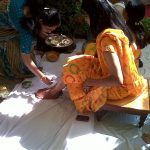The best way to get to know the culture of a community is to learn about how they celebrate events. The Sindhi wedding is a blend of traditional and fun that ensures that the friends and family of the bride and the groom give them a great start to their new life.
Pre Wedding Sindhi Wedding Functions
Kacchi and Pakki Engagements
Kachhi Misri: The family of the bride and the groom meet formally for the first time after finalizing the match. The Kachhi Misri is an informal engagement. The families exchange gifts such as clothes and fruits. The bride and groom exchange sugar (Mishri) and coconuts. This is an informal engagement, and the couple get to know each other better after this. The groom’s sister drapes a red dupatta over the bride’s head, places five different fruits in her lap, and feeds her sweets.
Pakki Misri: The formal engagement is closer to the wedding. The groom’s family gifts the bride a Lehenga, clothes, jewelry, and other gifts. The groom’s sisters-in-law and sisters place these gifts on the bride’s lap. His mother gives the bride’s mother a pot filled with Mishri, which she opens in front of everyone. Seven married women assist the mother in drawing the image of Lord Ganesh on this pot to mark the auspiciousness of the engagement. A priest performs pooja, and the couple exchanges rings. A red saree is placed on the bride’s head, and she wears this saree for the wedding ceremony. The priest also consults the horoscopes of the bride and the groom and selects an auspicious date for the marriage. The bride’s and groom’s families exchange sweets. The Sindhi wedding rituals begin.
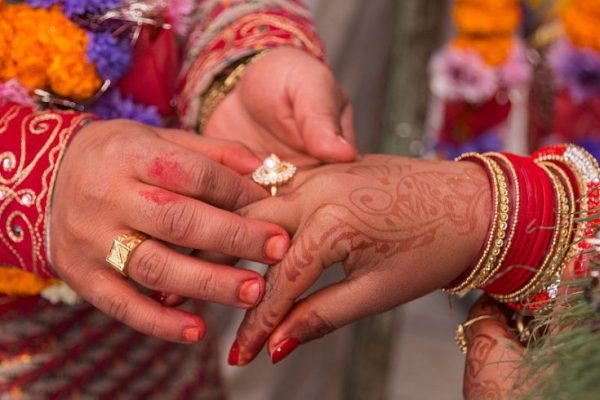
Pre Wedding Functions
Berana Satsang: The families of the bride and the groom gather for a prayer meeting called the Berana Satsang. They pray to the Almighty Jhulelal to bless the couple and ask for blessings. The family also sings traditional prayer songs, and in some cases, they employ the services of professional singers for the same. A brother-in-law is the guardian or Anaar of the bride and must do her bidding till the wedding. A similar ceremony is held at the groom’s home. The bride and groom do not leave the confines of their homes after this ceremony.
Lada: The groom’s family hosts a Lada or Sangeet where the gathering sings folk songs accompanied by drums and dancing.
Tih: The bride’s family priest visits the groom’s house with a bag of rice, sugar, spices, a coconut, a ball of green silk yarn, twenty one sweets, and nine dates. He also carries the Lagna chart of the proposed marriage, Muhurat and he conducts a Ganesh Pooja at the groom’s house with the items that he has brought and places the paper on the groom’s lap.
Priest – Wanwas Pooja
Wanwas: A priest visits the bride’s house and performs pooja to the previously installed deity. The women present apply a turmeric paste to the bride. Seven married women pour oil over the bride’s head, and she washes it off in a cleansing bath. A similar pooja and oil bath happens at the house of the groom. The groom tears his clothes away after the oil bath, symbolizing that he is leaving his single life behind.
Sagri or Mehendi: The bride’s family gathers at her home the day before the wedding. Henna designs are made on her hands and feet. There is singing and dancing. The groom’s family has a smaller Mehendi ceremony.
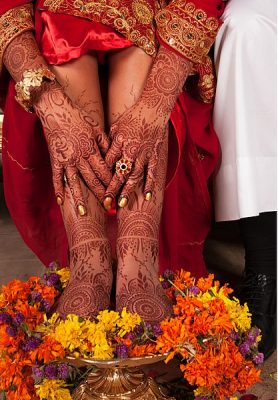
Navgrahi Pooja or Ghari Pooja: On the night before the wedding ceremony, the bride’s family and the groom’s family perform pooja to the nine planets and other deities in their homes. They invite Gods to the house as guests and pray for blessings and the removal of obstacles. The priest hands wheat grains to the bride and the groom and the women of the household grind the grains to flow. The bride and the groom break an earthen lamp with their feet in their respective homes.
Measuring the Groom: The sister in law of the bride or the groom measure the groom with a length of training and place knots on it. The women measure the groom on the day before the wedding and the wedding day to ensure that he is the same groom as the day before.
Sindhi Wedding Rituals Customs
Garo Dhago: On the morning of the wedding, a priest performs pooja and also ties a red thread on the wrists of the bride and the groom.
Baraat: The groom, friends, and family leave for the wedding venue with great pomp and celebration. The procession is called a Baraat, and there is much merriment.
Swagat: The bride’s mother welcomes the groom with an Arti. The entire Baraat is welcomed with sugar and cardamom, and they are sprinkled with rose water. A white sheet is held between the bride and the groom, and pooja is performed. The sheet is lowered and the couple gets the first look at each other on their wedding day.
Mandap Sindhi Wedding Functions
Pao Dulhai: The bride and groom are seated in the Mandap on a duvet gifted by the bride’s family. The bride’s parents wash the groom’s feet, and he is considered to be an embodiment of Lord Vishnu.
Jaimala: The bride and the groom exchange garlands thrice.
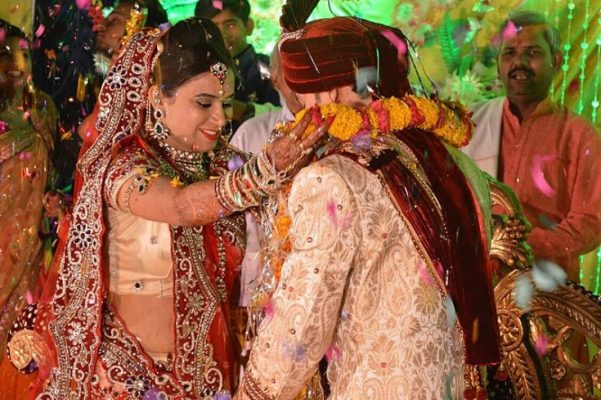
Palli Pallo: The groom’s sister ties the bride’s dupatta and the groom’s stole together while enclosing a few grains of rice in the knot.
Hathiyaala: The bride’s right hand and the groom’s right hand are tied together with a red cloth that signifies their bond. They circumambulate a holy fire four times. The groom walks ahead for three rounds and the bride for the fourth. In a Sindhi Sikh wedding, the couple goes around the Guru Granth Sahib four times.
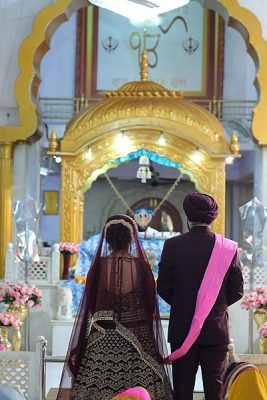
Kanyadaan: After the Sindhi wedding ceremony, the bride’s father symbolically gives the bride away into the care of the groom.
Saptapadi: The bride steps over seven piles of grains while the groom holds her hands, signifying their unity in overcoming hardships in life.
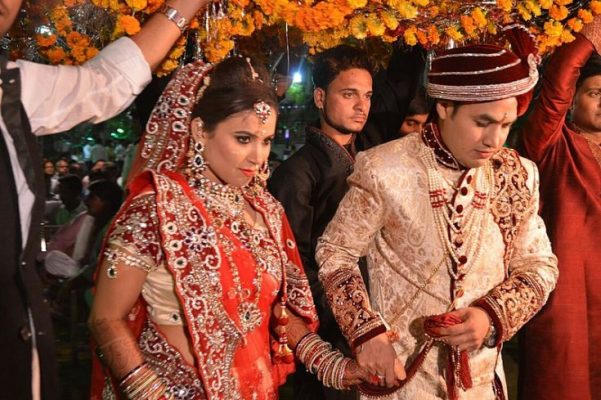
Post Wedding Sindhi Wedding Functions
Bidai: The bride’s family bids farewell to the bride. She leaves her maternal home for her marital home.
Datar: The bride’s feet are washed when she enters the marital home, and she enters, splashing milk around.
Salt Shagun: the bride transfers a handful of salt to the groom, who passes it back. They repeat this thrice.
Channar: On the day after the wedding, a priest removes the deity installed in the home before the wedding. The groom’s mother also feeds the couple a mixture of rice, milk, and sugar seven times.
Satawarah: The new couple visits the bride’s home at an auspicious time. The bride’s family showers the groom with gifts and there is a feast.
Gadjani: The groom’s family formally introduces the bride to the family. There is also a grand wedding reception. The Sindhi wedding functions end.








